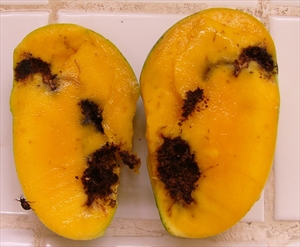Mango pulp weevil. It is also known as the mango fruit weevil.
Pacific Pests, Pathogens, Weeds & Pesticides - Online edition
Pacific Pests, Pathogens, Weeds & Pesticides
Mango pulp weevil (437)
Sternochetus gravis; previously, it was known as Sternochetus frigidus, Cryptorhynchus frigidus.
Asia, Oceania. It is recorded from Papua New Guinea.
Mango, cultivated and wild species.
The larvae do the damage by feeding in the flesh of the mango fruit making them unfit to eat (Photo 1). Externally, there may be no or little sign that the weevil is present inside the fruit. At most, there may be spots on the skin where the weevils lay eggs, or exit holes made by adults. Symptoms are similar to those made by the mango seed weevil, Sternochetus mangiferae (see Fact Sheet no. 353), except that this weevil eats the seed not the flesh.
Egg are laid into the fruit when they are more than 6 cm diameter; the eggs are then covered by gum and faeces. The grubs are white, legless, with brown or black heads. They tunnel into the flesh forming a chamber near the seed, and from there spread out into the flesh, leaving trails of frass. When mature, the larvae form chambers lined with frass, and develop into white to pale-red pupae, up to 10 mm long. Adults are 6-9 cm long, hard-bodied, mottle-brown with paler patches, and long snouts that tuck into a groove on the underside of the body (Photos 2-4). They remain in the fruit for about 30 days, and then escape by boring through the skin.
Spread of the weevil occurs by walking, and by flight - they are strong flyers but usually only disperse over short distances - and by being carried inside infested fruit that show no external signs of infestation. It is also possible that adults could be spread by the movement of planting material. Survival occurs inside the fruit, and also as adults on the ground under leaf litter and bark. The life cycle is about 35-50 days.
The impact of the weevil on mango crops is considerable: losses occur from premature fruit drop, and markets refusing to accept fruits that are potentially infested with weevils. In Indonesia, infestations of 30-80% have been recorded. The introduction of the weevil to any country where it is not yet present will cause loss of market access as well as expensive treatments.
Look for larvae, pupae and adults, as well as associated tunnels and frass, inside fruit. However, the mango pulp weevil looks very similar to the mango seed weevil and specimens should be examined by a taxonomist specialising in weevils to ensure an accurate identification. PaDIL gives a list of features for comparison between the two species (http://www.padil.gov.au/pests-and-diseases/pest/main/135555).
BIOSECURITY
Countries still free from the weevil|, or those that have areas recognised officially as free, and export the crops, should take all practical measures to prevent its introduction or further spread. The pest may spread as eggs, larvae, pupae, and adults within the flesh. Visual inspection of the fruit is not sufficient to determine infestation. If introduction and establishment of the weevil should occur, it may result in the termination of trade arrangements.
To contain the risk of further spread of the mango weevil, 'area freedom' should be used as a management strategy, following the guidelines of the International Standards for Phytosanitary Measures, Food and Agriculture Organization (FAO), Publication No. 10 Requirements for the establishment of pest free places of production and pest free production sites.
NATURAL ENEMIES
The weaver ant, Oecophylla smaragdina (see Fact Sheet no. 386), may keep trees free from the weevil. No other natural enemies of significance of eggs or larvae have been recorded.
CULTURAL CONTROL
During growth:
- Collect fallen fruit and destroy them by burning or burying deeply (at least 50 cm). They contain larvae, pupae and/or adults.
- Harvest the fruits as soon as possible, just before they are ripe.
- Bag individual fruits when they are immature, about 6 cm diameter (less than the size of a chicken's egg). Paper can be used, with a hole at the bottom to allow water to drain.
CHEMICAL CONTROL
This is not an effective method of control as the life stages are inside the fruit. However, the synthetic pyrethroid, lambda-cyhalothrin has been recommended in the Philippines, and in India, a single application of a persistent insecticide has been suggested at the time of fruit-setting. Furthermore, see treatments used in Australia for measures against mango seed weevil (Sternochetus mangiferae) (see Fact Sheet no. 353).
Even if chemical control treatments are applied, they should be combined with those under cultural control above.
____________________
When using a pesticide, always wear protective clothing and follow the instructions on the product label, such as dosage, timing of application, and pre-harvest interval. Recommendations will vary with the crop and system of cultivation. Expert advice on the most appropriate pesticide to use should always be sought from local agricultural authorities.
AUTHOR Grahame Jackson
Information from Mango pulp weevil (2019) Business Queensland. Queensland Government. (https://www.business.qld.gov.au/industries/farms-fishing-forestry/agriculture/crop-growing/priority-pest-disease/mango-pulp-weevil); and from CABI (2019) Cryptorhynchus frigidus (mango fruit weevil). Crop Protection Compendium. (https://www.cabi.org/cpc/datasheet/16432). Photo 1 Mango pulp weevil. Business Queensland, Queensland Government. Australia. Photos 2-4 Walker, K (2005) Mango Pulp Weevil (Sternochetus frigidus): PaDIL - (http://www.padil.gov.au).
Produced with support from the Australian Centre for International Agricultural Research under project HORT/2016/185: Responding to emerging pest and disease threats to horticulture in the Pacific islands, implemented by the University of Queensland and the Secretariat of the Pacific.







